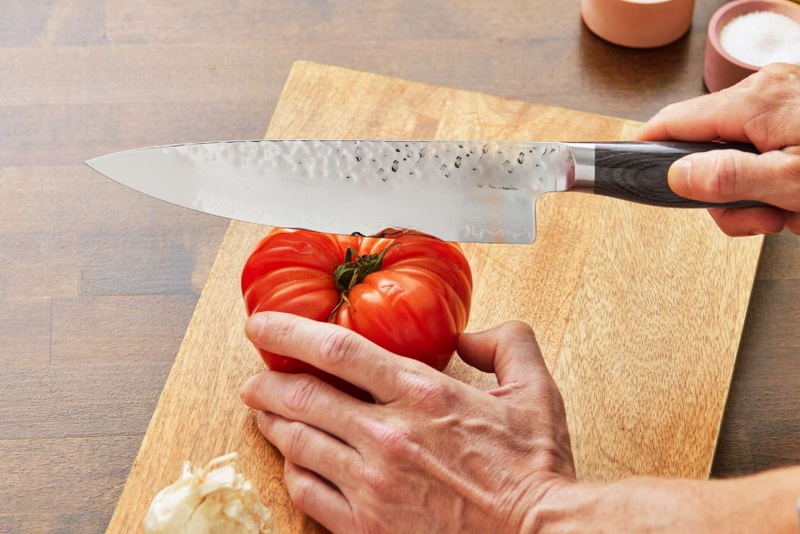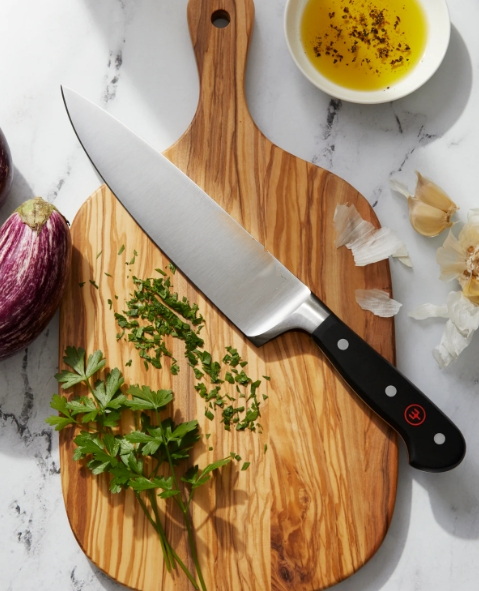

Views: 222 Author: Ella Publish Time: 2025-05-05 Origin: Site








Content Menu
● The Versatility of a Chef Knife
● Why a Chef Knife is Essential in the Kitchen
>> 2. Efficiency and Ease of Use
>> 3. Safety
● The Impact of a Quality Chef Knife on Cooking
● Choosing the Right Chef Knife
● How to Care for Your Chef Knife
● Mastering Knife Skills with a Chef Knife
● The Role of a Chef Knife in Different Cuisines
● Common Mistakes to Avoid When Using a Chef Knife
● FAQ
>> 1. What Makes a Chef Knife Different from Other Kitchen Knives?
>> 2. How Long Should a Chef Knife Blade Be?
>> 3. How Do I Keep My Chef Knife Sharp?
>> 4. Can I Put My Chef Knife in the Dishwasher?
>> 5. Why Is a Sharp Knife Safer Than a Dull One?
A chef knife is undoubtedly the cornerstone of any kitchen, whether you are a professional chef or a home cook. Its versatility, precision, and efficiency make it the most essential tool for preparing almost every dish. This article explores why the chef knife holds such a vital place in the kitchen, how to choose the right one, and how to maintain it for long-lasting performance. We will also delve into the nuances of knife skills, the impact of a quality chef knife on cooking outcomes, and practical tips for integrating this indispensable tool into your culinary routine.

The chef knife is designed to perform a wide range of kitchen tasks with precision and ease. Its broad, curved blade allows for rocking motions that make chopping, slicing, and dicing efficient and safe. Here are some of the many uses of a chef knife:
- Slicing fruits and vegetables with clean, precise cuts
- Dicing onions, shallots, and herbs finely
- Breaking down poultry and filleting fish
- Crushing garlic cloves
- Transferring chopped ingredients to pots or pans
This multi-functionality means you can rely on a single knife for most of your kitchen prep work, reducing clutter and the need for multiple specialized knives. For example, when preparing a stir-fry, a chef knife can quickly chop vegetables, mince garlic, and slice meat, streamlining the process and saving valuable time.
Understanding the parts of a chef knife helps in choosing the right one for your needs:
- Blade: Typically made from high-carbon stainless steel, the blade's sharpness and durability depend on the steel's composition. A sharp blade cuts cleanly, preserving the texture and flavor of food. The blade usually tapers to a fine edge, allowing for delicate slicing as well as robust chopping.
- Handle: Should feel comfortable and offer a secure grip to prevent hand fatigue during long prep sessions. Ergonomic designs improve control and safety. Handles come in various materials such as wood, plastic, or composite, each offering different tactile experiences and maintenance requirements.
- Tang: The metal part extending into the handle. Full tang knives offer better balance and durability compared to partial tang knives. A full tang runs the entire length of the handle, providing strength and stability, which is crucial for heavy-duty kitchen tasks.
The balance between blade and handle weight is also critical. A well-balanced chef knife feels like an extension of your hand, enhancing precision and reducing strain.
A sharp chef knife allows for clean, precise cuts that improve the presentation and cooking of food. Uniform slices cook evenly and look more appealing. For example, evenly sliced vegetables roast uniformly, enhancing both texture and flavor. Precision also affects texture; delicate herbs and soft fruits can be sliced thinly without bruising, preserving their natural qualities.
A well-balanced chef knife reduces the effort needed to slice through tough ingredients, speeding up meal prep and reducing fatigue. The curved blade facilitates a rocking motion that is both ergonomic and effective, allowing continuous cutting without lifting the knife off the cutting board. This technique is faster and safer than chopping with a straight up-and-down motion.
Sharp knives are safer than dull ones because they require less force and are less likely to slip, reducing the risk of accidents. A dull blade can easily slide off the surface of an ingredient, causing unintended cuts. Proper knife skills combined with a sharp blade minimize these risks significantly.
High-quality chef knives made from premium materials can last decades with proper care, making them a worthwhile investment. Unlike cheaper knives that lose their edge quickly or break, a well-made chef knife can be sharpened repeatedly and withstand rigorous kitchen use.
From chopping vegetables to carving meats, the chef knife can handle nearly every kitchen task, making it the ultimate all-purpose tool. This versatility means you don't need a drawer full of specialized knives; one good chef knife can replace many.

Using a high-quality chef knife can transform your cooking experience in several ways:
- Improved Food Quality: Precise cuts preserve the integrity of ingredients, enhancing texture and flavor. For instance, cleanly sliced fish fillets cook more evenly and look more appetizing.
- Enhanced Cooking Speed: Efficient cutting techniques reduce prep time, allowing you to focus more on cooking and presentation.
- Reduced Waste: Sharp knives minimize crushing and tearing, which helps retain more usable food and reduces waste.
- Greater Enjoyment: Handling a well-balanced, sharp knife makes food preparation more enjoyable and less tiring, encouraging you to cook more often and experiment with new recipes.
When selecting a chef knife, consider the following:
- Blade Length: Most home cooks prefer an 8-inch blade, which balances weight and control. However, blades range from 6 to 12 inches depending on hand size and cooking style. Larger blades are better for heavy-duty tasks like cutting large vegetables or meat, while smaller blades offer more precision for delicate work.
- Material: High-carbon stainless steel offers a good balance of sharpness, durability, and corrosion resistance. Some knives use Damascus steel for enhanced strength and aesthetic appeal.
- Handle Comfort: Choose a handle that feels like an extension of your hand to reduce fatigue and improve precision. Handles made from natural materials like wood provide warmth and grip, while synthetic materials can offer better durability and hygiene.
- Tang Type: Full tang knives provide better balance and strength. Partial tang knives are lighter but may be less durable.
- Weight and Balance: The knife should feel balanced in your hand, neither too heavy nor too light, allowing for smooth, controlled cuts.
Testing a knife in person, if possible, is the best way to find a comfortable fit.
Proper maintenance ensures your chef knife stays sharp and safe:
- Wash by hand with warm, soapy water and dry immediately; avoid dishwashers to prevent damage.
- Never soak the knife, as prolonged exposure to water can damage the blade and handle.
- Regularly sharpen your knife using a whetstone or professional sharpening service to maintain the edge. Honing with a steel rod between sharpenings realigns the blade edge and prolongs sharpness.
- Store knives safely in a block or magnetic strip to protect the blade and prevent accidents. Avoid tossing knives loosely in drawers where the edge can be damaged.
- Periodically oil wooden handles to prevent drying and cracking.
Owning a quality chef knife is only part of the equation; mastering proper knife skills elevates your cooking:
- The Rocking Chop: Place the tip of the blade on the cutting board and rock the knife back and forth to chop herbs or vegetables quickly and safely.
- Julienne and Batonnet Cuts: These precise cuts create uniform sticks of vegetables, ideal for stir-fries and salads.
- Dicing: Using a series of horizontal and vertical cuts, dice onions and other vegetables into uniform cubes for even cooking.
- Slicing: Use smooth, long strokes to slice meats and fruits without crushing the fibers.
- Mincing: Finely chop garlic or herbs by repeatedly running the knife over the ingredient with a controlled rocking motion.
Practicing these techniques improves speed, safety, and the quality of your dishes.
The chef knife's importance transcends cultural boundaries, playing a pivotal role in various culinary traditions worldwide. In French cuisine, the chef knife is fundamental for preparing intricate dishes requiring precise cuts and delicate presentation. Japanese chefs often use specialized knives, but the Western-style chef knife is increasingly popular for its versatility. In Mediterranean cooking, where fresh vegetables, herbs, and meats are staples, the chef knife facilitates quick and efficient preparation. Understanding the knife's role in different cuisines highlights its universal value and adaptability.
To maximize the benefits of your chef knife, avoid these common pitfalls:
- Using the Wrong Cutting Surface: Hard surfaces like glass or granite can dull your blade quickly. Use wooden or plastic cutting boards to preserve sharpness.
- Applying Excessive Force: Let the sharpness of the knife do the work. Pressing too hard can cause slips and injuries.
- Ignoring Knife Maintenance: Neglecting sharpening and honing leads to dull blades, increasing risk and reducing efficiency.
- Improper Grip: Holding the knife incorrectly reduces control and can cause fatigue. Use a pinch grip, holding the blade between thumb and index finger for better maneuverability.
- Cutting in Unsafe Directions: Always cut away from your body and keep fingers tucked under to prevent accidents.
The chef knife is the most important kitchen tool because it combines versatility, precision, efficiency, and safety in one indispensable instrument. Investing in a high-quality chef knife and maintaining it properly will elevate your cooking experience, making food preparation faster, more enjoyable, and professional in quality. Whether you are slicing vegetables or carving meat, the chef knife is your trusted companion in the kitchen. Mastering knife skills and understanding the anatomy and care of your chef knife will ensure it remains a reliable tool for years to come, transforming your culinary endeavors into a more rewarding and creative process.

A chef knife has a broad, curved blade designed for rocking motions, allowing it to perform a wide variety of tasks like chopping, slicing, and dicing, unlike specialized knives which are designed for specific tasks.
Most home cooks prefer an 8-inch blade as it offers a good balance between control and cutting power, but blades can range from 6 to 12 inches depending on your needs and hand size.
Regular sharpening with a whetstone or professional sharpening service is essential. Honing your knife with a honing steel between sharpenings helps maintain the edge.
No, dishwashers can damage the blade and handle due to harsh detergents and clanging. Always hand wash and dry your knife immediately after use.
A sharp knife requires less force to cut, reducing the chance of slipping and accidents. Dull knives crush food and require more pressure, increasing risk.